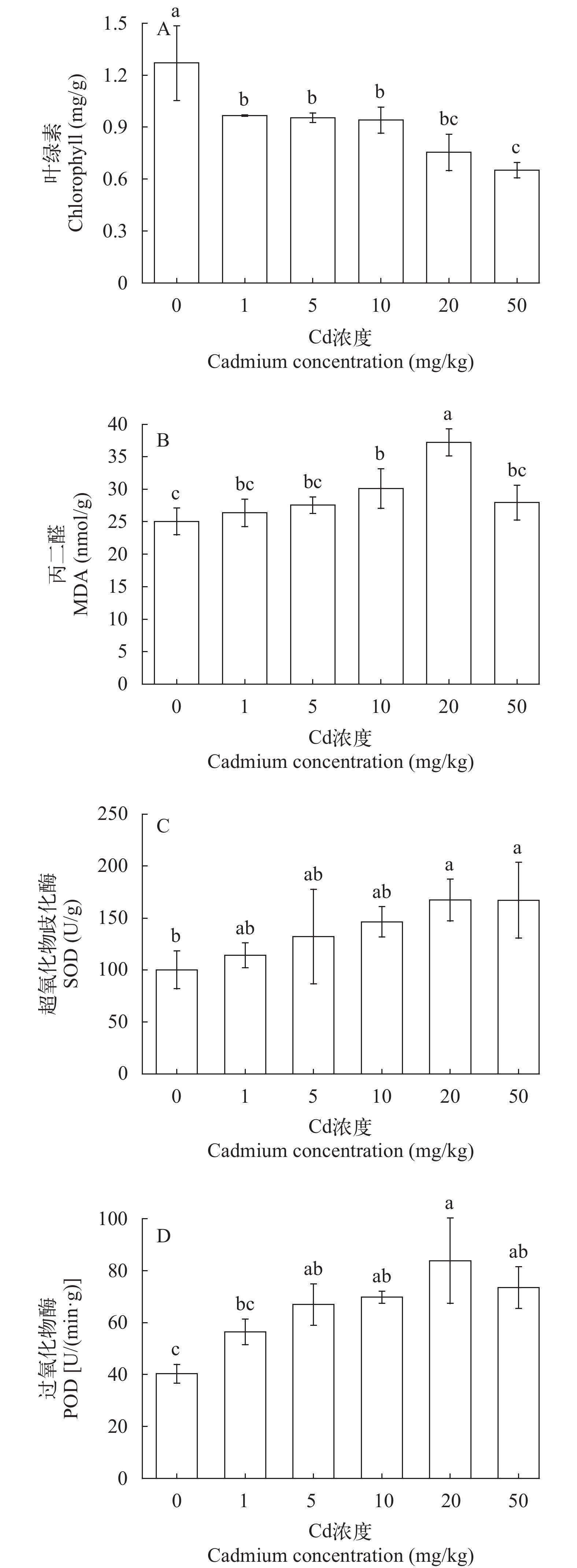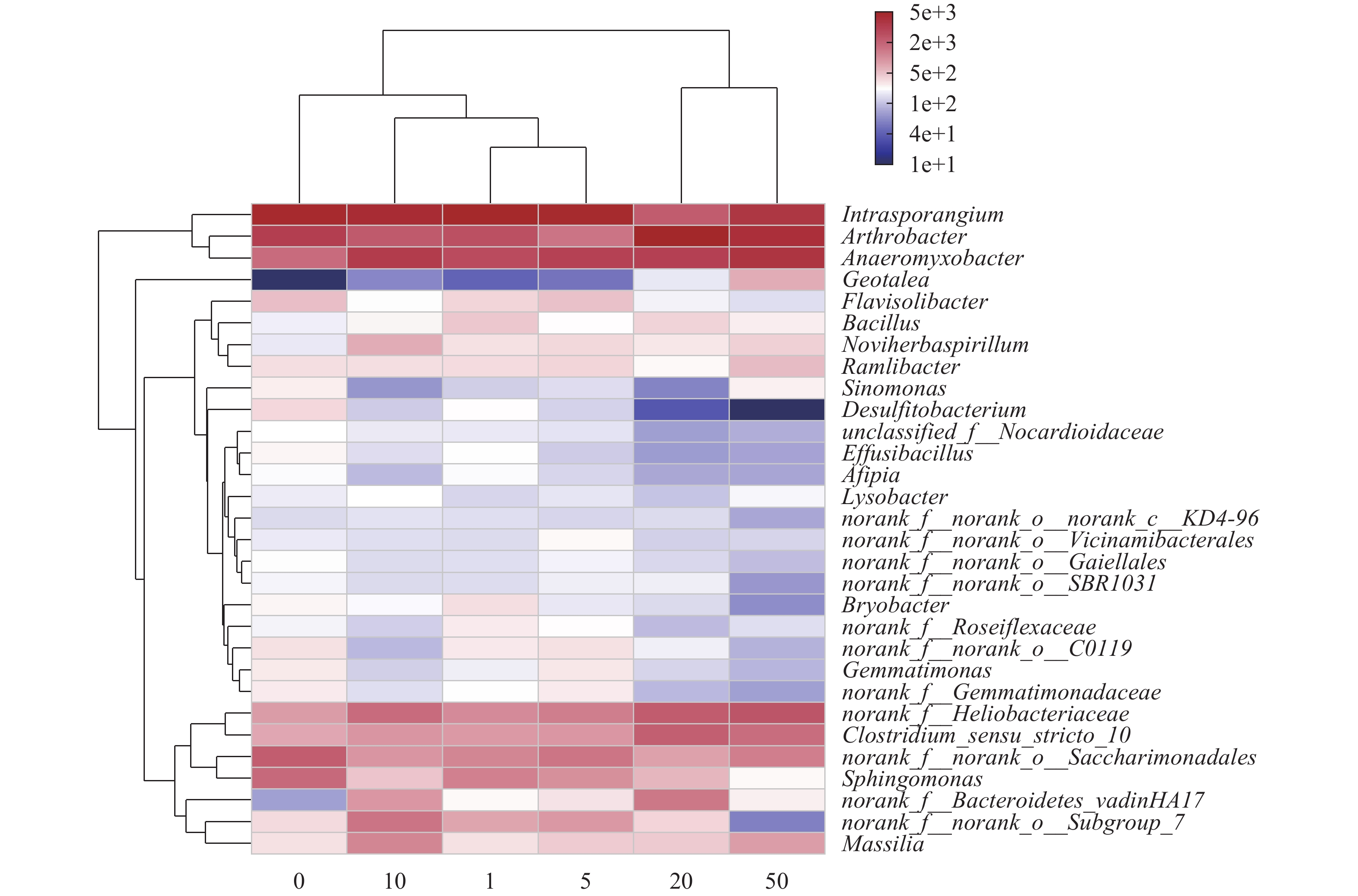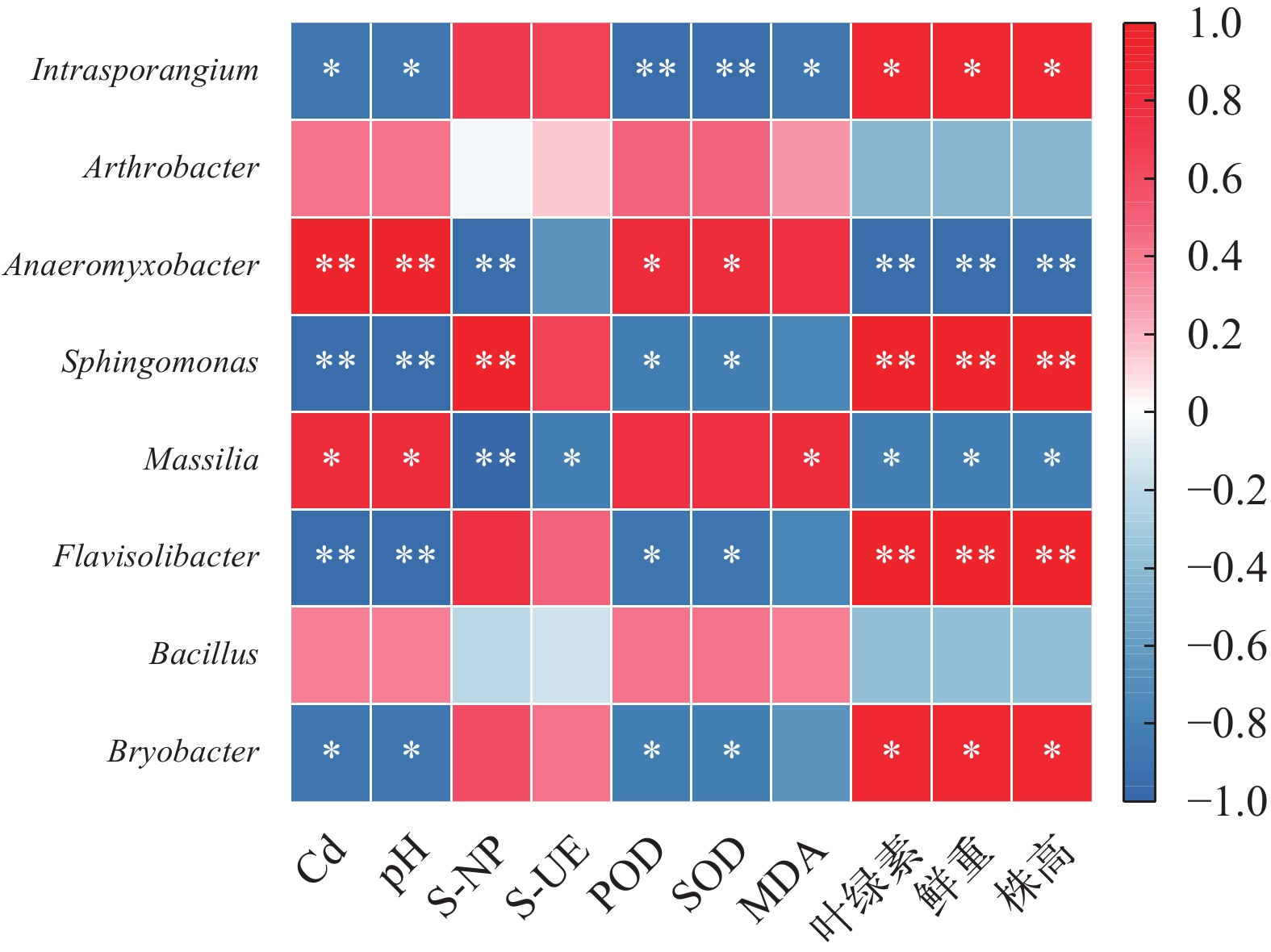RESPONSE CHARACTERISTICS OF VALLISNERIA NATANS AND RHIZOSPHERE MICROBIAL COMMUNITY UNDER SEDIMENT-CADMIUM POLLUTION
-
摘要:
研究以典型沉水植物苦草(Vallisneria natans)为研究对象, 通过在0、1、5、10、20和50 mg/kg沉积物镉(Cd)污染环境下苦草鲜重、株高和叶绿素(Chlorophyll)及丙二醛(Malondialdehyde, MDA)、超氧化物歧化酶(Superoxide Dismutase, SOD)和过氧化物酶(Peroxidase, POD)活性测定来分析苦草对镉的耐受效应, 并借助生物/底泥富集因子(BSAF)和植物转运因子(TF)来了解苦草的富集能力, 同时利用16S rRNA基因扩增子测序技术研究苦草根际细菌的群落结构对沉积物镉污染环境下的响应特征。结果表明: (1) 当Cd≥20 mg/kg处理时, 苦草植株鲜重、株高、叶绿素含量和抗逆能力下降, SOD和POD活性先上升后下降, MDA含量上升; (2) BSAF均超过1表明苦草能有效地富集污染底泥中的镉, 转运系数(TF)均小于1, 说明苦草依靠根滤机制来富集镉, 建议在收获苦草时需要定期连根去除; (3) 测序结果表明苦草根际由放线菌门、厚壁菌门和变形菌门等37个门细菌组成, 包含鞘氨醇单胞菌属、黄杆菌属、马赛菌属、芽孢杆菌属和节杆菌属等植物促生细菌, 这些细菌可能在促进苦草生长、耐受和富集重金属镉起到重要作用。研究分析了苦草在镉胁迫环境下形态学和生理生化等相关指标的变化和苦草根际细菌群落组成及其对镉胁迫的响应特征, 为后续提高苦草修复效果提供了基础。
Abstract:In this study, the typical submerged macrophyte Vallisneria natans was selscted, and the fresh weight, plant height, chlorophyll, malondialdehyde (MDA), superoxide dismutase (SOD) and peroxidase (POD) activities of Vallisneria natans were measured at 0, 1, 5, 10, 20 and 50 mg/kg of sediment cadmium contamination to analyze the cadmium tolerance effect of Vallisneria natans, and the enrichment capacities were indicated by the values of Biota-sediment accumulation factor (BSAF) and translocation factor (TF), while the 16S rRNA gene amplicon sequencing technique was used to study the community structure of Vallisneria natans rhizosphere bacteria response to the sediment cadmium contamination. The results showed that: (1) When Cd≥20 mg/kg treatment, the fresh weight, plant height, chlorophyll content and the stress resistance decreased of Vallisneria natans. The activities of SOD and POD increased firstly and then reduced, MDA content increased with increasing concentration; (2) in all the treatments, BSAF exceeded 1, indicating that Vallisneria natans could effectively enrich cadmium in the contaminated sediment, and TF was less than 1, indicating that Vallisneria natans relied on root filtration mechanism to enrich cadmium, and needed to be harvested regularly; (3) the sequencing results showed that the rhizosphere bacteria of Vallisneria natans were mainly composed of 37 phylum, such as Actinobacteria, Firmicutes and Proteobacteria, including plant growth-promoting bacteria such as Sphingomonas, Flavisobacter, Massilia, Bacillus, and Arthrobacter, which may play important roles in promoting the growth, tolerance, and enrichment of cadmium in Vallisneria natans. In this study, we preliminarily analyzed the changes of morphological, physiological and biochemical indicators of Vallisneria natans under varied cadmium stress environments, and the composition of Vallisneria natans rhizosphere bacterial community and its response characteristics to cadmium stress, which provide guidance for the subsequent improvement of Vallisneria natans restoration efficiency.
-
Keywords:
- Sediment /
- Cadmium /
- Restoration /
- Microorganisms community /
- Vallisneria natans
-
-
表 1 不同浓度的镉处理对苦草生长的影响
Table 1 Effects of different Cd concentrations on growth of Vallisneria natans (mean±SD, n=3)
处理组Treatment
(mg/kg)整株生物量
Whole plant (g)株高
Plant height (cm)叶片
Leaf (mg/kg)根
Root (mg/kg)BSAF TF 0 3.123±0.534a 31.7±1.700a — — — — 1 2.712±0.157ab 27.4±0.432b 7.53±0.17e 15.33±0.78e 13.01±0.25a 0.49±0.01b 5 2.517±0.449abc 26.3±1.700b 14.73±0.37d 63.96±0.70d 6.84±0.31b 0.23±0.00d 10 2.429±0.393abc 24.9±0.660bc 32.30±0.13c 134.44±0.37c 6.01±0.16c 0.24±0.00d 20 2.092±0.209bc 23.7±1.247c 61.25±1.46b 183.52±1.66b 4.69±0.04d 0.33±0.00c 50 1.942±0.170b 18.5±0.508d 221.67±6.72a 365.84±4.75a 5.08±0.09d 0.61±0.01a 注: 表中数据为3个重复的平均值; 同一列相同右上角含有不同英文上标字母表示有显著差异(P<0.05); 下同Note: Data are means of triplicates. Means in each line sharing the different superscript are significantly different determined by Least test (P<0.05), the same applies below 表 2 沉积物pH、氮磷和酶活性
Table 2 pH, nitrogen and phosphorus, and enzyme activities of sediments (mean±SD, n=3)
处理组Treatment (mg/kg) 镉Cd (mg/kg) pH 总氮 TN (mg/kg) 总磷 TP (mg/kg) 脲酶 S-UE [μg/(d·g)] 磷酸酶 S-NP [μmol/(d·g)] 0 0.01±0.00e 5.46±0.02f 492.93±48.05a 134.58±10.01ab 97.76±4.09a 5.09±0.04a 1 0.72±0.01e 6.25±0.08e 324.07±52.56b 156.46±19.55a 93.86±3.92ab 4.52±0.15b 5 4.53±0.22d 6.37±0.01d 390.71±6.90b 127.90±11.36ab 80.96±12.05abc 4.50±0.22b 10 8.39±0.11c 6.62±0.02c 334.82±16.78b 139.77±12.49ab 66.56±5.71c 2.52±0.09d 20 17.58±0.46b 6.74±0.04b 350.79±50.02b 123.45±7.73b 76.87±13.01bc 2.93±0.08c 50 46.12±0.74a 7.04±0.01a 537.36±34.83a 147.19±18.38ab 88.30±3.64ab 2.77±0.04cd -
[1] Liu Y, Tie B, Peng O, et al. Inoculation of Cd-contaminated paddy soil with biochar-supported microbial cell composite: a novel approach to reducing cadmium accumulation in rice grains [J]. Chemosphere, 2020(247): 125850. doi: 10.1016/j.chemosphere.2020.125850
[2] 林绍霞, 柳小兰, 张转铃, 等. 贵州草海表层沉积物重金属污染特征与源解析 [J]. 农业环境科学学报, 2021, 40(2): 390-399. doi: 10.11654/jaes.2020-1078 Lin S X, Liu X L, Zhang Z L, et al. Heavy metal pollution characteristics and source apportionment in overlying deposits of Caohai Lake, Guizhou Province [J]. Journal of Agro-Environment Science, 2021, 40(2): 390-399. doi: 10.11654/jaes.2020-1078
[3] Xu M, Wang R, Yang X, et al. Spatial distribution and ecological risk assessment of heavy metal pollution in surface sediments from shallow lakes in East China [J]. Journal of Geochemical Exploration, 2020(213): 106490. doi: 10.1016/j.gexplo.2020.106490
[4] Wei J, Hu K, Xu J, et al. Determining heavy metal pollution in sediments from the largest impounded lake in the eastern route of China’s South-to-North Water Diversion Project: ecological risks, sources, and implications for lake management [J]. Environmental Research, 2022, 214(3): 114118.
[5] Li D, Yu R, Chen J, et al. Ecological risk of heavy metals in lake sediments of China: a national-scale integrated analysis [J]. Journal of Cleaner Production, 2022(334): 130206. doi: 10.1016/j.jclepro.2021.130206
[6] Yuan Q, Wang P, Wang X, et al. Phytoremediation of cadmium-contaminated sediment using Hydrilla verticillata and Elodea canadensis harbor two same keystone rhizobacteria Pedosphaeraceae and Parasegetibacter [J]. Chemosphere, 2022, 286(1): 131648.
[7] Wu B, Li J, Peng D, et al. Cadmium exposure alters rhizospheric microbial community and transcriptional expression of Vetiver Grass [J]. Frontiers in Plant Science, 2022(13): 808844. doi: 10.3389/fpls.2022.808844
[8] Rezania S, Taib S M, Md Din M F, et al. Comprehensive review on phytotechnology: heavy metals removal by diverse aquatic plants species from wastewater [J]. Journal of Hazardous Materials, 2016(318): 587-599. doi: 10.1016/j.jhazmat.2016.07.053
[9] 乔云蕾, 李铭红, 谢佩君, 等. 沉水植物对受重金属镉、锌污染的水体底泥的修复效果 [J]. 浙江大学学报(理学版), 2016, 43(5): 601-609. Qiao Y L, Li M H, Xie P J, et al. A study on the absorption of cadmium and zinc in the water sediments with submerged plants [J]. Journal of Zhejiang University (Science Edition), 2016, 43(5): 601-609.
[10] Huang S, Huang X, Cheng H, et al. Role of phosphorus in Vallisneria natans and biofilm exposure to Pb2+ and Cd2+ stress [J]. Science of The Total Environment, 2022(835): 155235. doi: 10.1016/j.scitotenv.2022.155235
[11] Wang L, Gao Y, Wang X, et al. Warming enhances the cadmium toxicity on macrophyte Myriophyllum aquaticum (Vell. ) Verd. seedlings [J]. Environmental Pollution, 2021(268): 115912. doi: 10.1016/j.envpol.2020.115912
[12] Sarwar N, Imran M, Shaheen M R, et al. Phytoremediation strategies for soils contaminated with heavy metals: modifications and future perspectives [J]. Chemosphere, 2017(171): 710-721. doi: 10.1016/j.chemosphere.2016.12.116
[13] Sharma P. Efficiency of bacteria and bacterial assisted phytoremediation of heavy metals: An update [J]. Bioresource Technology, 2021(328): 124835. doi: 10.1016/j.biortech.2021.124835
[14] Zhou X, Shi A, Rensing C, et al. Wood vinegar facilitated growth and Cd/Zn phytoextraction of Sedum alfredii Hance by improving rhizosphere chemical properties and regulating bacterial community [J]. Environmental Pollution, 2022(305): 119266. doi: 10.1016/j.envpol.2022.119266
[15] 朱桐豆. 粉绿狐尾藻及根际促生菌强化人工湿地净化镉污染水体研究 [D]. 郑州: 郑州大学, 2021: 29-41. Zhu T D. Study on the enhancement of constructed wetland purification of cadmium polluted water by Myriophyllum aquaticum and plant growth-promoting rhizobacteria [D]. Zhengzhou: Zhengzhou University, 2021: 29-41.
[16] Kushwaha P, Neilson J W, Maier R M, et al. Soil microbial community and abiotic soil properties influence Zn and Cd hyperaccumulation differently in Arabidopsis halleri [J]. Science of The Total Environment, 2022(803): 150006. doi: 10.1016/j.scitotenv.2021.150006
[17] 陈萍萍, 赵风斌, 王丽卿, 等. 铜离子胁迫对苦草生长特性及生理指标的影响 [J]. 生态与农村环境学报, 2013, 29(2): 230-233. Chen P P, Zhao F B, Wang L Q, et al. Effect of copperion stress on growth and physiological parameters of Vallisneria natans [J]. Journal of Ecology and Rural Environment, 2013, 29(2): 230-233.
[18] 陶理, 王沛芳, 袁秋生, 等. 4种典型沉水植物对去除镉污染底泥的应用效果 [J]. 环境科学, 2021, 42(9): 4311-4318. Tao L, Wang P F, Yuan Q S, et al. Application effect of four typical submerged macrophytes on removing cadmium from polluted sediment [J]. Environmental Science, 2021, 42(9): 4311-4318.
[19] Chen Z, Tian W, Li Y, et al. Responses of rhizosphere bacterial communities, their functions and their network interactions to Cd stress under phytostabilization by Miscanthus spp. [J]. Environmental Pollution, 2021(287): 117663. doi: 10.1016/j.envpol.2021.117663
[20] He T, Xu Z, Wang J, et al. Improving cadmium accumulation by Solanum nigrum L. via regulating rhizobacterial community and metabolic function with phosphate-solubilizing bacteria colonization [J]. Chemosphere, 2022(287): 132209. doi: 10.1016/j.chemosphere.2021.132209
[21] Lin Q, Fan M, Peng X, et al. Response of Vallisneria natans to aluminum phytotoxicity and their synergistic effect on nitrogen, phosphorus change in sediments [J]. Journal of Hazardous Materials, 2020(400): 123167. doi: 10.1016/j.jhazmat.2020.123167
[22] Abduro Ogo H, Tang N, Li X, et al. Combined toxicity of microplastic and lead on submerged macrophytes [J]. Chemosphere, 2022(295): 133956. doi: 10.1016/j.chemosphere.2022.133956
[23] Guo H, Jiang J, Gao J, et al. Evaluation of cadmium hyperaccumulation and tolerance potential of Myriophyllum aquaticum [J]. Ecotoxicology and Environmental Safety, 2020(195): 110502. doi: 10.1016/j.ecoenv.2020.110502
[24] Fan P, Liu C, Ke Z, et al. Growth and physiological responses in a submerged clonal aquatic plant and multiple-endpoint assessment under prolonged exposure to ciprofloxacin [J]. Ecotoxicology and Environmental Safety, 2022(239): 113690. doi: 10.1016/j.ecoenv.2022.113690
[25] Gou T, Yang L, Hu W, et al. Silicon improves the growth of cucumber under excess nitrate stress by enhancing nitrogen assimilation and chlorophyll synthesis [J]. Plant Physiology and Biochemistry, 2020(152): 53-61. doi: 10.1016/j.plaphy.2020.04.031
[26] 陈金梅, 褚一凡, 谭启洋, 等. 外源脱落酸对湿地植物美人蕉抗寒性的影响 [J]. 水生生物学报, 2021, 45(6): 1264-1272. Chen J M, Chu Y F, Tan Q Y, et al. Study on increase of the cold resistance and overwintering effect of Canna indica Linn in constructed wetland by abscisic acid [J]. Acta Hydrobiologica Sinica, 2021, 45(6): 1264-1272.
[27] Liu Q, Chen Z, Tang J, et al. Cd and Pb immobilisation with iron oxide/lignin composite and the bacterial community response in soil [J]. Science of The Total Environment, 2022(802): 149922. doi: 10.1016/j.scitotenv.2021.149922
[28] 陈兆进, 林立安, 李英军, 等. 镉胁迫对芒草根际细菌群落结构、共发生网络和功能的影响 [J]. 环境科学, 2021, 42(8): 3997-4004. doi: 10.13227/j.hjkx.202011198 Chen Z J, Lin L A, Li Y J, et al. Shifts in rhizosphere bacterial community structure, co-occurrence network, and function of Miscanthus following cadmium exposure [J]. Environmental Science, 2021, 42(8): 3997-4004. doi: 10.13227/j.hjkx.202011198
[29] Wang J, Chen X, Chu S, et al. Influence of Cd toxicity on subcellular distribution, chemical forms, and physiological responses of cell wall components towards short-term Cd stress in Solanum nigrum [J]. Environmental Science and Pollution Research, 2021, 28(11): 13955-13969. doi: 10.1007/s11356-020-11505-5
[30] Wang L, Gao Y, Jiang W, et al. Microplastics with cadmium inhibit the growth of Vallisneria natans (Lour.) Hara rather than reduce cadmium toxicity [J]. Chemosphere, 2021(266): 128979. doi: 10.1016/j.chemosphere.2020.128979
[31] He L, Wang B, Cui H, et al. Clay-hydrochar composites return to cadmium contaminated paddy soil: Reduced Cd accumulation in rice seed and affected soil microbiome [J]. Science of The Total Environment, 2022(835): 155542. doi: 10.1016/j.scitotenv.2022.155542
[32] 朱志国, 周守标. 铜锌复合胁迫对芦竹生理生化特性、重金属富集和土壤酶活性的影响 [J]. 水土保持学报, 2014, 28(1): 276-280+288. doi: 10.3969/j.issn.1009-2242.2014.01.053 Zhu Z G, Zhou S B. Effects of physiological and biochemical characteristics, accumulation of Arundo donax and soil enzyme activities under combined stress of Cu and Zn [J]. Journal of Soil and Water Conservation, 2014, 28(1): 276-280+288. doi: 10.3969/j.issn.1009-2242.2014.01.053
[33] Huang Y, Chen J, Sun Y, et al. Mechanisms of calcium sulfate in alleviating cadmium toxicity and accumulation in pak choi seedlings [J]. Science of The Total Environment, 2022(805): 150115. doi: 10.1016/j.scitotenv.2021.150115
[34] Guo Z, Lv J, Zhang H, et al. Red and blue light function antagonistically to regulate cadmium tolerance by modulating the photosynthesis, antioxidant defense system and Cd uptake in cucumber (Cucumis sativus L.) [J]. Journal of Hazardous Materials, 2022(429): 128412. doi: 10.1016/j.jhazmat.2022.128412
[35] Li Y, Chen H, Song L, et al. Effects on microbiomes and resistomes and the source-specific ecological risks of heavy metals in the sediments of an urban river [J]. Journal of Hazardous Materials, 2021(407): 124472.
[36] Bandara T, Krohn C, Jin J, et al. The effects of biochar aging on rhizosphere microbial communities in cadmium-contaminated acid soil [J]. Chemosphere, 2022(303): 135153. doi: 10.1016/j.chemosphere.2022.135153
[37] Zhang H, Wan Z, Ding M, et al. Inherent bacterial community response to multiple heavy metals in sediment from river-lake systems in the Poyang Lake, China [J]. Ecotoxicology and Environmental Safety, 2018(165): 314-324. doi: 10.1016/j.ecoenv.2018.09.010
[38] Ali Q, Ayaz M, Yu C, et al. Cadmium tolerant microbial strains possess different mechanisms for cadmium biosorption and immobilization in rice seedlings [J]. Chemosphere, 2022(303): 135206. doi: 10.1016/j.chemosphere.2022.135206
[39] Li M, Guo R, Yu F, et al. Indole-3-acetic acid biosynthesis pathways in the plant-beneficial bacterium Arthrobacter pascens ZZ21 [J]. International Journal of Molecular Sciences, 2018, 19(2): 443-458. doi: 10.3390/ijms19020443
[40] Sangsuwan P, Prapagdee B. Cadmium phytoremediation performance of two species of Chlorophytum and enhancing their potentials by cadmium-resistant bacteria [J]. Environmental Technology & Innovation, 2021(21): 101311.
[41] Sarria Carabalí M M, García-Oliva F, Cortés Páez L E, et al. Effect of cadmium contamination on the rhizosphere bacterial diversity of Echinocactus platyacanthus [J]. Rhizosphere, 2020(13): 100187. doi: 10.1016/j.rhisph.2020.100187
[42] Lin H, Liu C, Li B, et al. Trifolium repens L. regulated phytoremediation of heavy metal contaminated soil by promoting soil enzyme activities and beneficial rhizosphere associated microorganisms [J]. Journal of Hazardous Materials, 2021(402): 123829. doi: 10.1016/j.jhazmat.2020.123829
[43] Hu L, Li Q, Yan J, et al. Vegetation restoration facilitates belowground microbial network complexity and recalcitrant soil organic carbon storage in southwest China Karst region [J]. Science of the Total Environment, 2022(820): 153137. doi: 10.1016/j.scitotenv.2022.153137
[44] Liu H, Wang H, Wang G. Intrasporangium chromatireducens sp. nov., a chromate-reducing actinobacterium isolated from manganese mining soil, and emended description of the genus Intrasporangium [J]. International Journal of Systematic and Evolutionary Microbiology, 2012, 62(Pt 2): 403-408.
[45] Liu C, Lin H, Li B, et al. Responses of microbial communities and metabolic activities in the rhizosphere during phytoremediation of Cd-contaminated soil [J]. Ecotoxicology and Environmental Safety, 2020(202): 110958. doi: 10.1016/j.ecoenv.2020.110958
[46] Zhou X, Zhang X, Ma C, et al. Biochar amendment reduces cadmium uptake by stimulating cadmium-resistant PGPR in tomato rhizosphere [J]. Chemosphere, 2022(307): 136138. doi: 10.1016/j.chemosphere.2022.136138
[47] 胡利伟, 轩贝贝, 戴华鑫, 等. 宏转录组测序揭示褐土脲酶基因的表达丰度和细菌来源 [J]. 烟草科技, 2020, 53(11): 7-14. Hu L W, Xuan B B, Dai H X, et al. Expression abundances of urease genes and microbe sources of urease in cinnamon soil revealed via metatranscriptomic sequencing [J]. Tobacco Science & Technology, 2020, 53(11): 7-14.
[48] Puthusseri R M, Nair H P, Johny T K, et al. Insights into the response of mangrove sediment microbiomes to heavy metal pollution: ecological risk assessment and metagenomics perspectives [J]. Journal of Environmental Management, 2021(298): 113492. doi: 10.1016/j.jenvman.2021.113492
[49] Wang L, Wang L A, Zhan X, et al. Response mechanism of microbial community to the environmental stress caused by the different mercury concentration in soils [J]. Ecotoxicology and Environmental Safety, 2020(188): 109906. doi: 10.1016/j.ecoenv.2019.109906
[50] Wu B, He T, Wang Z, et al. Insight into the mechanisms of plant growth promoting strain SNB6 on enhancing the phytoextraction in cadmium contaminated soil [J]. Journal of Hazardous Materials, 2020(385): 121587. doi: 10.1016/j.jhazmat.2019.121587
[51] 李交昆, 余黄, 曾伟民, 等. 根际促生菌强化植物修复重金属污染土壤的研究进展 [J]. 生命科学, 2017, 29(5): 434-442. doi: 10.13376/j.cbls/2017057 Li J K, Yu H, Zeng W M, et al. Research progress on plant growth promoting rhizobacteira and their role in phytoremediation of heavy metal-contaminated soil [J]. Chinese Bulletin of Life Sciences, 2017, 29(5): 434-442. doi: 10.13376/j.cbls/2017057
[52] 王会会, 李前正, 李亚华, 等. 根际促生菌对沉水植物的促生效应及其与沉积物氮磷赋存形态的关系 [J]. 水生生物学报, 2021, 45(2): 299-307. doi: 10.7541/2021.2020.008 Wang H H, Li Q Z, Li Y H, et al. The effect of PGPR on submerged macrophyte and its relationship with the sediment nitrogen and phosphorus forms [J]. Acta Hydrobiologica Sinica, 2021, 45(2): 299-307. doi: 10.7541/2021.2020.008




 下载:
下载:



